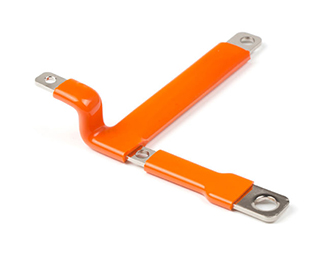2025-04-03 10:12:46
In high-frequency and high-temperature applications, selecting the right Flexible Busbar material is crucial for ensuring the performance and reliability of electrical systems. Nickel Copper Flexible Busbar and traditional Copper Busbars are two common choices, each with distinct advantages in terms of conductivity, high-temperature resistance, corrosion resistance, and mechanical flexibility. This article compares the two based on the latest industry insights, helping customers make informed decisions.

Traditional copper busbars are known for their excellent electrical conductivity (~5.8×10⁷ S/m), making them ideal for high-current transmission. However, at high frequencies, the skin effect causes current to concentrate on the conductor's surface, increasing effective resistance and reducing transmission efficiency. Nickel Copper Flexible Busbar has a lower conductivity (~2.2×10⁷ S/m), but its surface plating optimizes high-frequency performance, minimizing the effects of the skin effect.
Nickel Copper Electrical Busbar exhibits excellent stability in high-temperature environments, with a melting point of approximately 1,200°C, significantly higher than pure copper’s 1,085°C. This makes Nickel Copper Flexible Busbar Custom solutions a better choice for extreme temperature applications, maintaining structural integrity and performance.
One of the biggest advantages of Nickel Copper Flexible Busbar is its exceptional corrosion resistance, especially in humid or chemically aggressive environments. Traditional copper busbars, in contrast, are more prone to oxidation and often require additional protective coatings such as tin or silver plating. This makes Nickel Copper Busbar a superior choice for applications in harsh conditions.
Unlike rigid copper busbars, Flexible Busbar is composed of multiple thin copper foils laminated together, providing excellent flexibility. This makes Flexible Electrical Busbar ideal for applications where bending or vibration resistance is required. Traditional copper busbars, with their solid structures, are less adaptable to dynamic or space-constrained environments.
In high-frequency applications, the multilayer structure and surface properties of Nickel Copper Flexible Busbar help reduce losses caused by the skin effect, improving signal transmission quality. Flexible Busbar System is particularly effective in electrical power distribution and industrial automation setups. In contrast, traditional copper busbars tend to suffer from higher signal attenuation and energy losses at high frequencies.
The manufacturing cost of Nickel Copper Flexible Busbar Supplier solutions is generally higher than that of traditional copper busbars. However, its long-term benefits—such as enhanced durability, improved efficiency, and lower maintenance costs—make it a worthwhile investment for businesses looking for Customized Busbar Solutions tailored to demanding environments.
Considering the above factors, Nickel Copper Flexible Busbar demonstrates clear advantages in high-frequency, high-temperature applications, especially where superior thermal resistance, corrosion protection, and mechanical flexibility are required. However, traditional copper busbars still hold an edge in low-frequency, high-current transmission applications.
For customers looking for optimized power distribution solutions, Nickel Copper Flexible Busbar Custom services provide a tailored approach to meet specific project needs. Whether you need a Flexible Electrical Busbar for aerospace, automotive, or renewable energy applications, our Nickel Copper Flexible Busbar Supplier solutions ensure efficiency and reliability in every project.